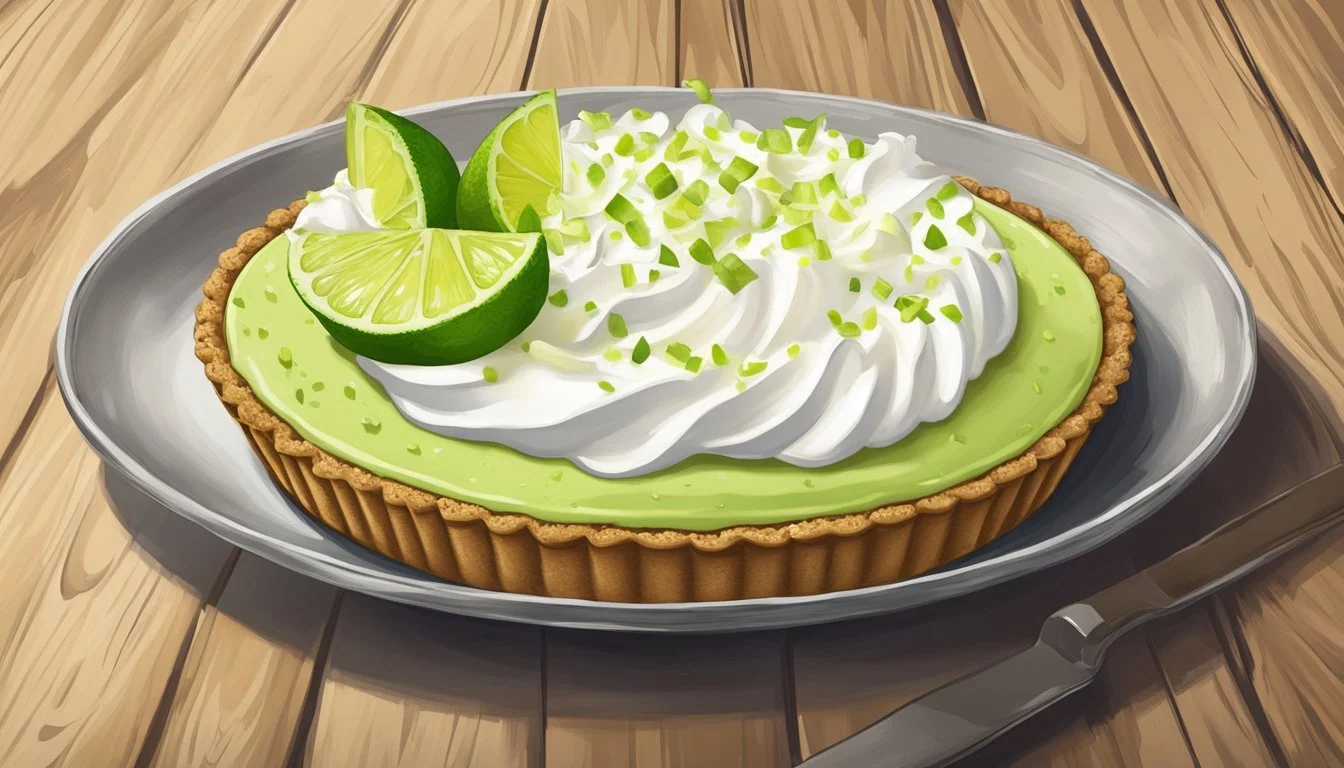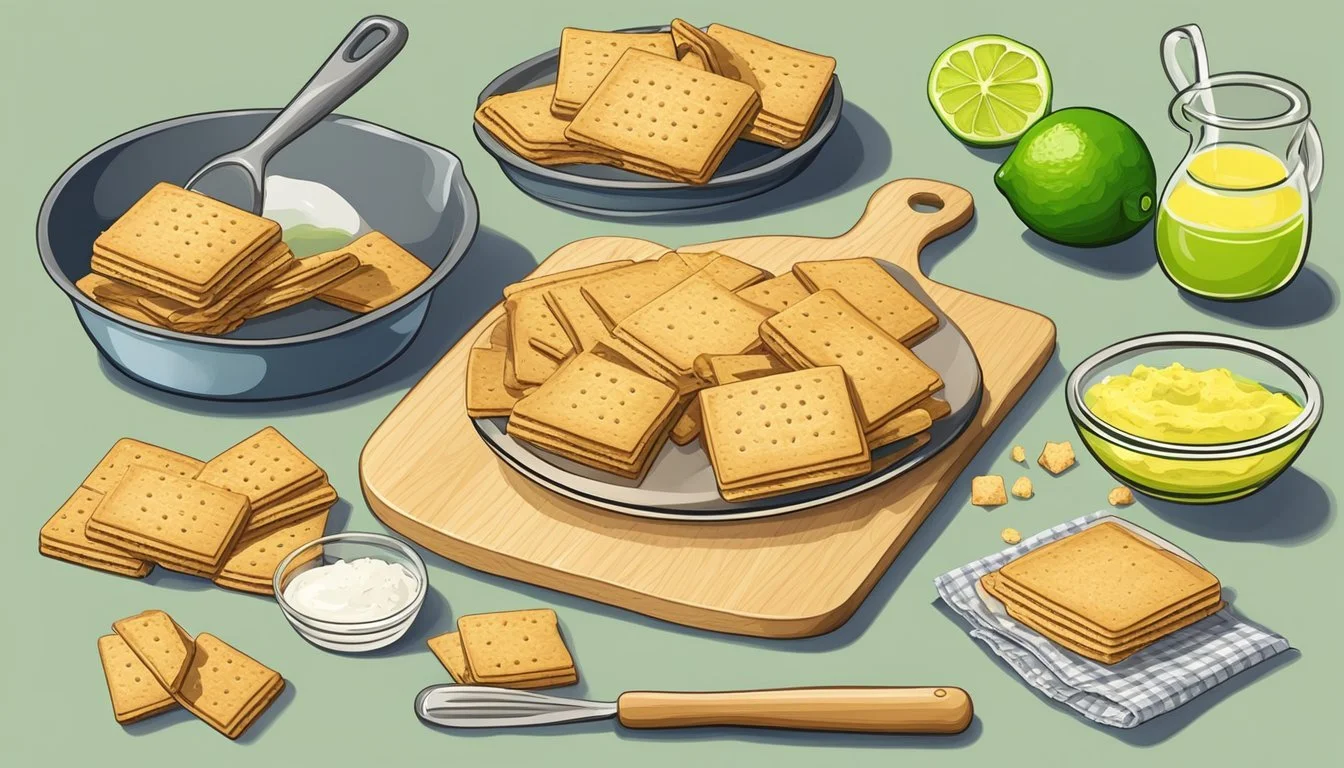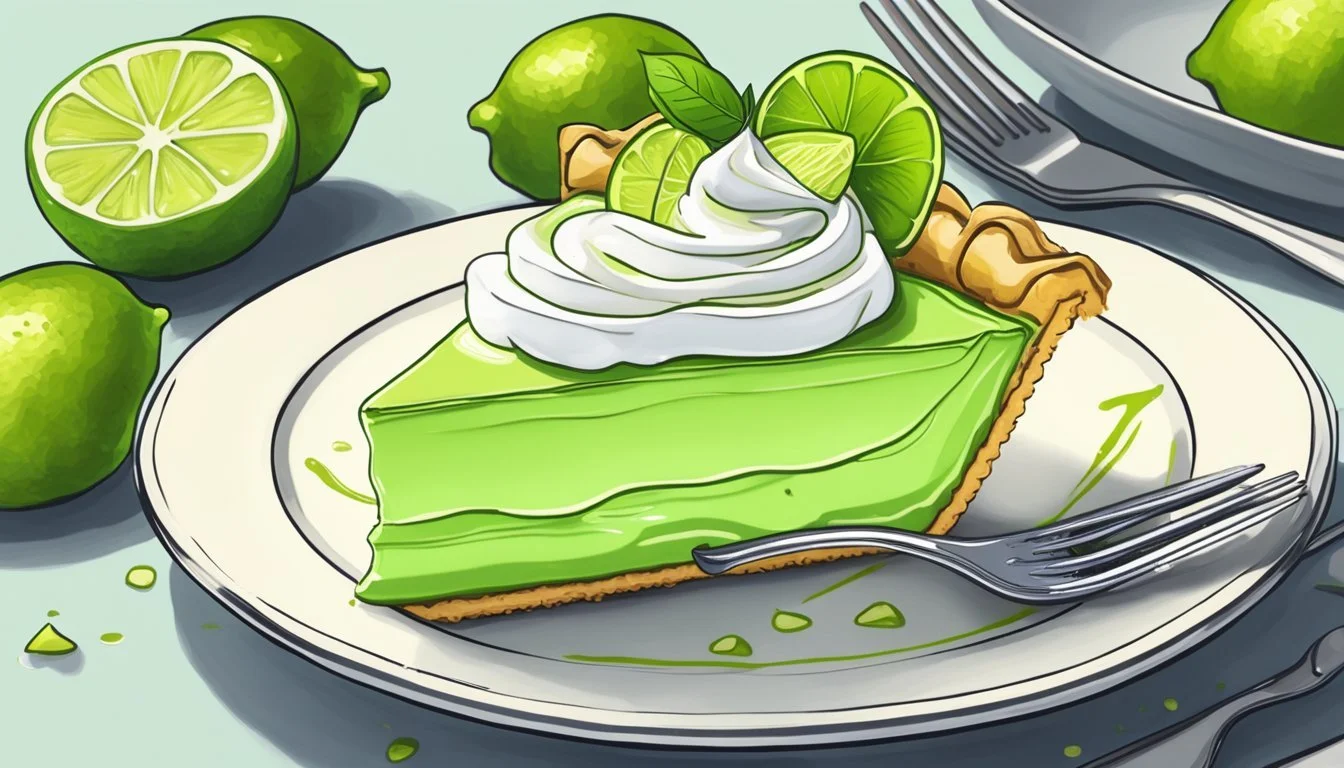How do you eat a key lime pie?
Mastering the Art of Enjoying this Classic Dessert
Key lime pie, with its smooth, citrusy filling and sweet graham cracker crust, stands as a hallmark of Floridian cuisine and a favorite dessert for many. Often topped with a dollop of whipped cream (how long does cream last?) or a light meringue, this confectionery delight marries tangy and sweet flavors in a way that has garnered it fans across the globe. Properly eating a key lime pie involves appreciating its unique texture and taste balance, ensuring every bite includes each layer of its composition.
Enjoying a slice of key lime pie begins with a fork, used to pierce through the layers of meringue or whipped cream, smooth lime filling, and the crunchy crust beneath. The art of savoring a key lime pie lies in the eater's ability to embrace the zest of the key limes contrasted against the sweetness of the meringue and the savory, buttery crust. Whether served chilled for a refreshing bite or at room temperature for a fuller flavor profile, key lime pie offers a versatile eating experience.
This dessert is typically served after cooling and setting, allowing the flavors to meld together properly. It's common to chill the pie for several hours or even overnight, which makes the pie more firm, enhancing the experience. The pie's signature flavor comes from the use of genuine key lime juice, which is more aromatic and less bitter than the juice of regular limes, providing the authentic taste that key lime pie enthusiasts have come to cherish.
The Origin of Key Lime Pie
Key Lime Pie is a renowned American dessert, with roots deeply embedded in the Florida Keys—a string of tropical islands stretching about 120 miles off the state's southern tip. According to local lore, the pie was invented during the late 19th century. The small, aromatic Key limes that give the pie its distinct taste are more potent than their sibling, the common Persian lime.
Traditionally, the authentic Key Lime Pie consists of a unique combination of lime juice, egg yolks, and sweetened condensed milk. It is often served with a meringue or whipped cream topping and typically sits on a crumbly crust made from graham crackers or pastry.
Ingredients and Preparation
Crust: Graham cracker or pastry-based
Filling: Made from Key lime juice, egg yolks, and sweetened condensed milk
Topping: Typically whipped cream or meringue
Florida's Contribution
Florida and the Florida Keys, in particular, are considered the birthplace of Key Lime Pie. It is suggested that "Aunt Sally," a cook in Key West's Curry Mansion, was among the first to formalize the recipe. Her access to sweetened condensed milk, a key ingredient, allowed for the creation of this dessert even before refrigeration was common.
Migration of Key Limes
The Key limes themselves, which are integral to the authentic flavor of the pie, originally hailed from Southeast Asia, likely introduced to the Florida Keys via Spanish explorers. In an unfortunate turn of events, the great hurricane of 1926 decimated the Key lime groves, leading to the use of the more readily available Persian lime.
From these historical threads, Key Lime Pie has become a cultural emblem of Florida, reflecting the state's agricultural heritage and colorful history.
Key Ingredients
To create an authentic key lime pie, one must carefully select the right ingredients that not only provide the signature tart flavor and creamy texture but also contribute to the structural integrity of the dessert.
The Citrus Foundation
The core of key lime pie is, unmistakably, the lime juice. Authentic recipes typically call for fresh key lime juice—from the small, aromatic key limes, not to be confused with the larger, less tart Persian limes. The zest of these limes, finely grated, infuses an intense citrus aroma throughout the dessert, distinguishing it from pies made with lemon juice or regular lime juice.
The Crust Essentials
The crust of the pie establishes the textural contrast to the filling. A classic graham cracker crust—comprising graham cracker crumbs, combined with melted unsalted butter—offers a crisp base. A store-bought pie crust can be used for convenience, but homemade crusts typically yield a fresher taste and a more satisfying crunch.
Binding Agents & Dairy
Binding agents like egg or egg yolks are crucial in achieving key lime pie's iconic custard texture. These, mixed with sweetened condensed milk, add a rich, creamy consistency. Alternatives like evaporated milk or heavy cream find use in variations of the recipe to adjust richness and firmness.
Sweetness & Flavor Enhancers
To balance the tartness of the limes, sweeteners such as powdered sugar or white sugar are included. Additions like vanilla extract often enhance the complexity of flavor. Garnishes may include whipped cream or meringue, often sweetened with confectioners' sugar, to complement the pie's zesty filling.
Preparing the Crust
A sumptuous key lime pie starts with a perfectly crafted crust. The foundation of the crust is typically a blend of graham cracker crumbs, butter, and sugar, prepared in a mixing bowl, shaped in a pie pan, and then baked to crisp perfection.
Mixing the Ingredients
The crust begins with a simple combination of graham cracker crumbs and melted butter. In a mixing bowl, one typically blends the crumbs with a proportionate amount of sugar to enhance the flavor. The exact amounts can vary, but a common ratio is about 1 and a half cups of crumbs to a third of a cup of melted butter and a quarter cup of sugar. These ingredients are mixed until well incorporated, creating a sandy and cohesive texture that will form the body of the crust.
Shaping and Baking
Once the mixture is ready, it's transferred to the pie pan. Here, chefs press the crumb mixture firmly into the bottom and up the sides to create an even layer that's about a quarter-inch thick. Molding is often done with fingers or a flat-bottomed glass to ensure the mixture is compacted. Afterwards, the crust is baked in a preheated oven at 350°F (180°C) for approximately 10 minutes or until slightly browned. Post-baking, the crust should be allowed to cool on a wire rack to ensure that it sets properly before filling.
Alternative Crust Options
While graham crackers are traditional, alternative crusts can offer a unique twist. Options include crushed cookies or nuts combined with butter to form the base. These varieties still follow the general steps of mixing and pressing into a pie pan but can provide different textures and flavors. For those looking for a no-bake option, the crust can be mixed and then refrigerated or frozen until firm – this is particularly useful when preparing bars instead of a pie. In cases where the crust might over-brown, covering the edges with aluminum foil during baking can prevent excessive darkening.
Creating the Filling
The filling of a key lime pie is its heart, showcasing a creamy texture and vibrant citrus flavor. A successful filling combines ingredients smoothly to achieve the signature tartness balanced with sweetness.
Combining the Ingredients
For the custard filling, one will typically start with egg yolks; these should be whipped using an electric mixer until thick and pale. Next, sweetened condensed milk is gradually added to the eggs, continuing to beat the mixture to incorporate air. One should always use fresh lime juice for a bright, authentic flavor, and adding lime zest will intensify the citrus kick while adding depth to the pie's profile.
Essential Ingredients:
Egg yolks (from 4-5 large eggs)
1 can (14 oz) sweetened condensed milk
1/2 cup fresh lime juice
1 tablespoon lime zest (optional)
Texture and Consistency
Achieving the desired consistency relies on precise preparation. The mixture should be whisked until it reaches a cohesive and homogenous state; it should not be lumpy or separated. An even and smoothly thickened texture will ensure that the filling sets correctly during baking and results in the creamy, quintessential texture one expects in a key lime pie.
Adding Flavors
Additional flavors such as vanilla extract can be whisked into the filling to complement the tartness of the lime. When all ingredients are fully combined and the filling is smooth, it should be gently poured into the pre-baked crust using a spatula to spread evenly. Covering the pie with plastic wrap in advance of chilling will prevent a skin from forming on the surface.
Final Touches and Toppings
When perfecting a key lime pie, the choices in toppings can enhance the dessert's flavor profile and overall presentation. Each topping option can complement the tartness of the lime with its own unique taste and texture.
Meringue vs Whipped Cream
Meringue offers a light, airy texture with a sweet flavor that balances the acidic nature of the key lime filling. A meringue topping consists of whipped egg whites and powdered sugar, baked until it forms a crisp and golden layer. For those endeavoring to make a meringue topping, one must whip the egg whites to stiff peaks, gradually adding sugar until the mixture is glossy, then carefully spread over the pie before baking until golden.
On the other hand, whipped cream provides a cool, creamy contrast that complements the density of the pie. To make whipped cream, one would beat heavy cream with powdered sugar until it reaches soft peaks. This topping should be added just before serving to maintain its texture.
Garnishes
Garnishes not only add visual appeal but also provide additional layers of flavor to key lime pie. Common garnishes include:
Lime slices: Freshly cut lime slices can be placed atop the pie to amplify the citrus theme and give a hint of the pie's main flavor.
Lime zest: Grating lime zest over the pie infuses a potent lime aroma and an extra kick of tartness.
Additionally, one might choose to lightly dust powdered sugar over either meringue or whipped cream to add a subtle sweetness and a polished look. Garnishes should be applied sparingly to avoid overpowering the key lime pie's natural flavor.
Baking and Cooling
When baking a key lime pie, precise oven time is essential for achieving the desired texture, while proper setting and chilling ensure the pie's structure and flavor are at their peak.
Oven Time
Key lime pie crust requires baking before adding the filling. Baking the crust alone in a preheated oven at 325°F (163°C) or 350°F (180°C) varies from 10 minutes to slightly longer until marginally browned. Once the crust has cooled, the filling is added, and the pie may return to the oven for an additional bake, depending on the recipe specifics. It is crucial to wrap the pie edges with aluminum foil to prevent over-browning.
Setting and Chilling
After the key lime pie is baked, it must be allowed to settle at room temperature on a wire rack. This step is vital for the texture to stabilize before it is refrigerated. Refrigeration should be done at 36°F (2°C) to 40°F (4°C), typically for several hours but it could vary depending on the recipe. For those that prefer a firmer texture, freezing the pie is an option, though it should be wrapped in plastic wrap to maintain its quality. A key lime pie should be thawed in the refrigerator if it has been frozen for extended storage.
Serving and Storage
Proper serving and storage of Key lime pie are essential for maintaining its distinct flavor and creamy texture. Serving it chilled with the right accompaniments can enhance the experience, while proper storage ensures freshness for later enjoyment.
How to Serve
Key lime pie is best served chilled. Individuals should take the pie out of the refrigerator just before serving. To cut clean slices, one should use a sharp knife dipped in warm water. For presentation, they can garnish each slice with a dollop of whipped cream or a small meringue, and possibly a thin slice of lime for added flair. If they are serving key lime pie bars, a spatula may be a more suitable utensil for lifting the bars out of the pie dish.
Storage Tips
For storage, pie should be kept in a pie dish, covered with plastic wrap or aluminum foil to protect it from absorbing other flavors. It is best to keep the pie refrigerated if it's going to be consumed within a week. The pie or pie bars can also be placed in an airtight container for additional protection. If a longer storage period is needed, it's advisable to freeze the pie. To do this securely, one should wrap the pie thoroughly in plastic wrap, then a layer of aluminum foil. A frozen pie can typically last for 2-3 months. Thawing should be done in the refrigerator rather than at room temperature to prevent bacterial growth and maintain the pie's structure.
Key Lime Pie Variations
Key Lime Pie, a dessert loved for its refreshing aroma and tangy-sweet flavor, comes in a range of variations. Whether one seeks a substitution for a classic ingredient or a completely different presentation of the dessert, these variations cater to diverse tastes and occasions.
Pie Alternatives
Bars: Ideal for portability and ease of serving, Key Lime Pie can be transformed into bars. The recipe is similar, but bars are sliced after chilling in a square or rectangular pan, providing a different experience through a familiar flavor.
Frozen Key Lime Pie: For a cool twist, the pie can be served frozen. This variation brings a custard-like consistency closer to ice cream, offering a refreshing option for warmer weather.
Key Lime Custard: A deconstructed key lime pie, where the crust, filling, and topping are served separately, focuses on the creamy custard element, allowing individuals to enjoy the flavors in a new format.
Substitutes and Additions
Sour Cream: For a richer, creamier texture, some recipes suggest adding sour cream to the key lime filling, which also helps in setting the custard.
Lemon Meringue Inspiration: Infusing the classic key lime pie recipe with elements of lemon meringue, chefs might top a key lime base with a fluffy meringue before lightly torching it for a caramelized finish.
Ingredient Substitutions Description Persian Lime Juice For a milder tartness, one may replace key lime juice with Persian lime juice. Lemon Juice Lemon juice is another substitute, offering a different citrus twist on the traditional aromatic profile.
Through this array of variations, one can experience the quintessential Key Lime Pie recipe in multiple forms, tailored to personal preferences or specific dietary requirements without compromising the essence of this cherished dessert.
Nutritional Information
When indulging in key lime pie, being aware of its nutritional profile can guide dietary choices. The calorie count for a typical slice of key lime pie (1/8 of a 9-inch diameter pie) can range from approximately 310 to 440 calories, depending on the specific recipe and serving size.
In terms of fat content, a slice may contain between 17 to 22 grams of fat, with saturated fat constituting a substantial portion. For example, some key lime pies may possess around 11 grams of saturated fat per serving. The presence of saturated fats makes moderation key, particularly for individuals monitoring their heart health.
Sugar content is another significant aspect, given the dessert's sweet nature. Key lime pie generally contains a high amount of sugars, contributing to the overall calorie count and taste profile – nutritional specifics, however, can vary by recipe.
Dietary restrictions also merit consideration. Traditionally, key lime pie contains ingredients such as eggs, butter, and dairy, which are not suitable for vegan diets. Gluten may also be present in the crust, posing a concern for individuals with celiac disease or gluten intolerance.
For those tracking their nutrient intake:
Calories: Approximately 310-440 per slice
Fat: 17-22g (Saturated Fat: ~11g)
Sugars: High (varies by recipe)
Dietary Restrictions: Typically not vegan or gluten-free
Consumers should note that variations in ingredients and portion sizes will affect the nutritional values. Reading labels or inquiring about the specific content can provide more precise information.
Common Questions
When enjoying key lime pie, one might encounter questions about ingredients and types, specifically regarding the limes used and the origin of the pie itself. This section addresses those curiosities directly.
Key Limes vs Regular Limes
Key limes are smaller, more aromatic, and typically more tart than the larger Persian limes commonly found in grocery stores. Key lime juice is essential for an authentic key lime pie flavor, imparting a distinct tartness and aroma not typically replicated by regular lime juice. Persian limes may result in a pie that lacks the characteristic zestiness of one made with true key lime juice.
Key limes: small, yellowish-green, tart.
Persian limes (regular limes): larger, darker green, less tart.
Homemade vs Store-Bought
A homemade key lime pie often reflects personal touch and freshness. Making the crust oneself allows for customization; using butter, graham cracker crumbs, and sugar hand-pressed into a pie dish can elevate the overall taste.
Homemade crust: potentially fresher, customizable, potentially more flavor.
Conversely, store-bought pie crust can offer convenience and consistency. When time or resources are limited, selecting a store-bought crust or a completely pre-made store-bought pie allows one to enjoy key lime pie with minimal effort.
Store-bought crust: convenient, consistent in quality.
Store-bought pie: quick option, less control over flavor profile.












